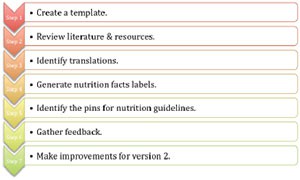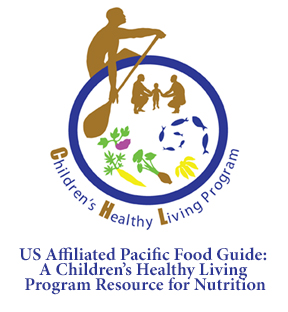
Development of the Guide
Developing the Pacific Food Guide:
the Children’s Healthy Living Program Resource for Nutrition
A multi-step process was used to develop the Guide. First, an outline template was created as a guide to list foods from the United States Affiliated Pacific USAP. To reflect the uniqueness of the region, the template was organized into three neutral categories: Walks along the Ground (e.g., animals), Chosen from the Sea (e.g., seafood), and Grown from the Ground (e.g., plants). Each food item includes the scientific name(s) and the common name in English and the various languages of the region. Brief descriptions on the physical appearance, preparation, and nutrition facts of the foods are also noted, as modeled by the Traditional Food Guide for Alaska Native Cancer Survivors resource. Additionally, selection and storage information are provided.
Second, a review of the resources available on the foods of the USAP, which includes books, booklets, pamphlets, textbooks, and websites, was conducted to identify foods that fit into each of the three categories. The goal of the Guide is to provide brief but comprehensive information with all information about a single food item presented on one page to make it easy for navigation. However, some foods with similar characteristics were grouped together such as citrus fruits and the parrotfish family. Pictures were also identified for each food item using open source and original photographs from CHL staff and affiliates.

Figure 1. Diagram outlining the steps used to create the Pacific Food Guide: the Children’s Healthy Living Program Resource for Nutrition.
Third, to reflect the rich culture of languages in the USAP, the CHL network was used to identify the traditional names (i.e., language translations) of the foods included in the Guide. The CHL network comprises native peoples from the all USAP jurisdictions in addition to academic and cultural experts. Individuals who spoke one or more of the languages in the USAP were identified and asked to provide translations of all foods they were familiar with in their native language. This is a very important aspect of the Guide as this will ensure readers can identify a food item even if they do not know its English or scientific name. Any named translations for food items received from the CHL network were included along with food name translations found in the published literature and native language dictionaries available online.
Fourth, a nutrition facts label was created for each food based on existing food and nutrient databases and composition tables. This included the USDA Nutrient Data Laboratory, Hawai’i Foods Database, Hawai’i Seafood Council, and the Food and Agricultural Organization of the United Nations Library. The label was designed using the Genesis® R&D SQL Version 9.9.2.0 Product Development and Labeling Software, which is the commercial-grade food composition and nutrient analysis software from Elizabeth Steward Hands and Associates (ESHA) Research. Serving sizes were determined based on Nutritional Labeling and Education Act (NLEA) standards. These labels reflect the macronutrient and micronutrient highlights for each food item.
Fifth, in order to weave in the nutrition guidelines, a set of “pins” was created for both the USDA and SPC food and nutrient guidelines. The USDA and SPC pins reflect each organization’s classification of food groups, and each food was given pins in accordance with both USDA and SPC guidelines. This feature allows the reader to see where each food fits within the food and nutrition guidelines from both organizations.
For the initial version, all information and features were formatted into a Portable Document File (pdf) that simulated an online book. This version was used for instruction of the Fall 2013 section of Food Science and Human Nutrition (FSHN) 185: The Science of the Human Nutrition modified for the Pacific taught through the University of Hawai‘i Outreach College. Students’ perception on appropriateness of the Guide to instruct the class was assessed through survey. In addition, the complete file was emailed throughout the CHL network along with an online survey to evaluate content of the Guide and gather feedback. All comments, questions, and feedback were collected to guide the production of Version 2 of the Pacific Food Guide.


